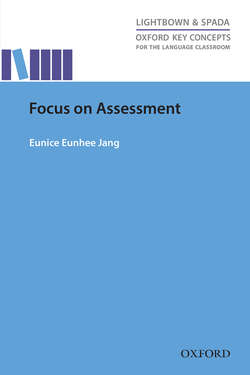Читать книгу Focus on Assessment - Eunice Eunhee Jang - Страница 5
На сайте Литреса книга снята с продажи.
Introduction
ОглавлениеThis book centers on teachers’ use of language assessment to guide students’ language proficiency development and academic achievement. It takes a use-focused approach to assessment in order to engage teachers in discussions about the positive benefits of assessment for guiding teaching and learning; the conflicting roles of teachers in the use of assessments that serve different purposes; and the practical challenges teachers experience when designing, using, and evaluating specific assessments.
Through these discussions, I hope that the book will help teachers to develop the competence and confidence required to make informed judgments about their assessment practices and to justify their decision-making processes. When we take this use-focused approach, teachers and students become ‘major league players’ in assessment, and their experience with and actual use of assessment in a particular context become key evidence for judging the quality of assessment.
Assessment practices are more important than ever in today’s Kindergarten to Grade 12 (K–12) classrooms given the unprecedented diversity of students, in terms of their linguistic, socio-economic, and cultural backgrounds. For these students, the instructional language is neither what they hear and speak at home nor the language with which they feel most competent and comfortable. These school-aged learners must catch up to ‘a moving target’ (Coelho, 2003). They are expected to develop social and academic language proficiency to meet language demands in schoolwork, while simultaneously learning academic content. Assessing their language learning needs and providing the necessary support have become not just second or foreign language teachers’, but every teacher’s responsibility. Most teachers and language educators have some knowledge and experience with educating language learners in classrooms. However, their assessment competence is relatively less developed partly because little attention is given to assessment issues and approaches concerning language learners in professional development for pre- and in-service teachers.
In some contexts, students learn a foreign language as part of curricular requirements or because they seek admission to higher education programs. Taken together, these students are referred to as language learners in this book. Because education systems vary widely across countries, I will consider children whose age ranges from 6–9 as young language learners. Early adolescent language learners will refer to students whose age ranges from 10–13, while adolescent language learners will refer to secondary school students aged 14–18 (14–17 in the UK and certain other countries).
This book has five chapters. Chapter 1 lays the groundwork for the readers by introducing language learners, identifying multiple roles that teachers play in assessments that serve various purposes, and introducing some key concepts of assessment. Subsequently, we look into the use of assessment in the form of feedback in classrooms and survey other uses of assessments in large-scale settings around the world.
Chapter 2 discusses the key features of academic language proficiency that school-aged students are expected to develop and examines research evidence to explore assessments of their language development in content-based instruction.
In Chapter 3, we will take into account some of the principles for assessing young language learners and discuss various assessment approaches and issues associated with them according to the purpose and degree of standardization of assessment.
In Chapter 4, we will continue to discuss assessment principles for adolescent language learners based on an ecological assessment systems framework.
Chapter 5 invites you to reflect on your views about the key issues discussed in the book and provides a summary of the main points raised in the earlier chapters.
Each chapter engages the reader through the use of Classroom Snapshots, Activities, and Spotlight Studies. Classroom Snapshots take you through authentic classroom situations and illustrate interactions between teachers and students or between students and their peers, as they engage in learning and assessment activities. Each chapter also contains a number of Activities to facilitate your inquiry-based reflection and discussion about specific issues arising from assessing language learners. Spotlight Studies will further inform your critical reflection and discussion, offering not only empirical evidence which will help answer questions but also an introduction to the different inquiry approaches taken, to seek evidence in particular assessment contexts.
The book concludes with Suggestions for Further Reading, along with brief annotations. This annotated list will introduce you to some excellent sources that will help continue your professional development and learning about language assessment. A Glossary at the end of the book provides brief definitions of some terms with which some readers may be unfamiliar. The terms included in the Glossary will appear in bold print the first time they are used in the text.
Throughout the book, the terms ‘test’ and ‘assessment’ are used interchangeably. In some cases, I use the term ‘assessment’ to refer to general assessment practice, not to a specific method. Assessment tasks refer to activities used in performance assessments. The test item refers to an individual question used for a selected-response test. The contexts of assessment which I consider in this book are ones in which English is learned as well as other languages. Students learning any additional language will be referred to as ‘language learners.’ Students learning English as a foreign (EFL) or a second language (ESL) will be referred to as English language learners (ELLs).
